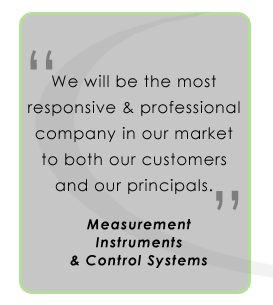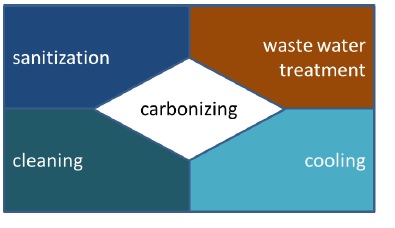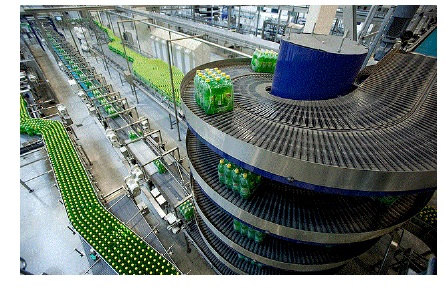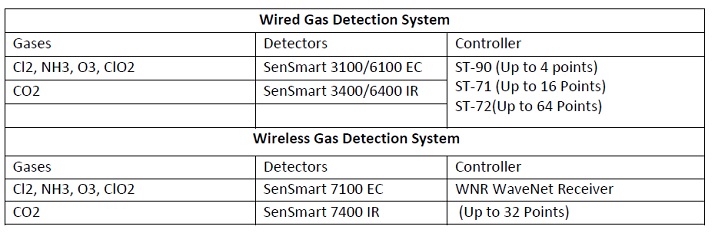|
RC Systems Application Note |
| December 2018, MARIETTA, GA ~ |
| Application Field: Food Processing, Brewery, Milk, Bottled Water, Soft-Drink Manufacturing |
|
Many gases are used for different reasons in the food and beverage producing industries. Water is the major raw material at the beginning and the end of the process, which has to be treated regarding odor and sterility. The vessels and pipes need to be cleaned regularly with sterilising fluids which can generate toxic gases that become a threat to workers. For carbonation and during fermentation, CO2 is used in high concentrations. The refrigerating and cooling system can contain pressurised ammonia which need to be monitored to protect people and property.
Containers in contact with food and processed raw materials, like water, need to be sterilized or disinfected. The sterilization of water required for the production of beverages is a significant subject due to the increased demand for water of good quality (taste, odor) by production plants. This can be done by applying gases like Ozone, Chlorine, Chlorine Dioxide or Hydrogen Peroxide. Generators produce the Ozone from air or oxygen with the aid of electrical discharges. It is then brought into contact with the medium being treated in reaction chambers. Chlorine is stored in cylinders and Chlorine Dioxide can be chemically generated on-site. Workers must have protection against leaks from the processes where these gases are used and stored.
Carbon Dioxide will be naturally generated by the fermentation of wine and beer or added later to carbonize the beverages. This gas can accumulate on low levels from leaks and lead to asphyxia if undetected. To prevent leaks and system brake-downs, gas detection system may be required to monitor the workplace insuring concentrations are below TLV. Chlorine Cl2 is a very toxic, corrosive gas used for disinfecting. It is stored in cylinders at high concentrations and blended down to the concentration used in the process or dissolved in water.  In more and more applications, Chlorine Dioxide ClO2 is used instead of Cl2. Traditional oxidizing agents (Chlorine and Bromine) suffer from pH constraints and corrosion problems. ClO2 in water is more stable than other oxidizing biocides and compatible with most water treatment chemistry. Chlorine Dioxide gas is a highly unstable substance. Long stagnation of the vapors will result in an explosive decomposition: 2ClO2 --> Cl2 + 2 O2 + heat. ClO2 vapors are reactive with most organic compounds.
Ozone (O3) is one of the strongest oxidizing agents available. It is used to eliminate organic waste, reduce color, odor and total organic carbon in water. Ozone is created in a number of different ways, including ultra violet (UV) light, corona discharge of electricity through an oxygen stream (including air), and several others. In treating small quantities of waste, UV ozonators are the most common, while large-scale systems use either corona discharge or other bulk ozone-producing methods. Ozone is formed as oxygen (O2) is struck by a source of energy. The bonds that hold the O2 together are broken and three O2 molecules combine to form two O3 molecules. The ozone begins to break down fairly quickly and doing so reverts back into O2. The bonds holding the oxygen atoms together are very weak, which explains why ozone acts as a strong oxidant. In environmental air, the O3 concentration can stay in the ppm ranges for a long time, making workplace monitoring essential.
Environmental back ground concentrations of O3 may also need be taken into account during Summer time. Sterilizing gases have strong affinity to humidity and surfaces, so if a sampling system is used all tubing should be TEFLON. If pressurized cooling fluids are being used in refrigerating and air conditioning systems, leak monitoring is essential. A small leak at a pipe joint can have a great impact and cause a lot of damage if not detected early. Cases are known where personnel have been intoxicated and stored goods have been destroyed by exposure to leaking Ammonia. Please refer to RC Systems APN-1042 for more information. In breweries and wineries odorless carbon Dioxide CO2 is naturally generated in the malting, fermentation and storage process. Because it is heavier than air, CO2 may collect in poorly ventilated areas or confined spaces in low level clouds replacing the oxygen. The same can happen in the beverage industry where CO2 is used for carbonation of soft drinks and mineral water. CO2 detectors are always used to monitor the concentrations and alert personnel and control fans. Selected thresholds for pre-alarms are 1000 ppm to 3000 ppm and main alarm is 5000 ppm for CO2. Transmitters should be mounted at low levels since CO2 is much heavier than air. They should be protected from mechanical damage and against water ingress if washed down occasionally.
|
|
RC Systems’ Recommendation:
|



 Under certain circumstances the gases from the chemicals in use can become a threat to human health, because they are either toxic or flammable. This is why workplace monitoring is necessary.
Under certain circumstances the gases from the chemicals in use can become a threat to human health, because they are either toxic or flammable. This is why workplace monitoring is necessary.
 The production process and the storage of goods require controlled temperature and environmental conditions, therefore refrigerating and cooling systems are widely used. Cooling fluids like Ammonia, Hydrocarbons or Halogenated Hydrocarbons are circulating in the cooling systems under pressure and can leak to pose a danger to workers. Monitored areas which should be considered are heat exchanger, joints, the compressor and valves.
The production process and the storage of goods require controlled temperature and environmental conditions, therefore refrigerating and cooling systems are widely used. Cooling fluids like Ammonia, Hydrocarbons or Halogenated Hydrocarbons are circulating in the cooling systems under pressure and can leak to pose a danger to workers. Monitored areas which should be considered are heat exchanger, joints, the compressor and valves.


